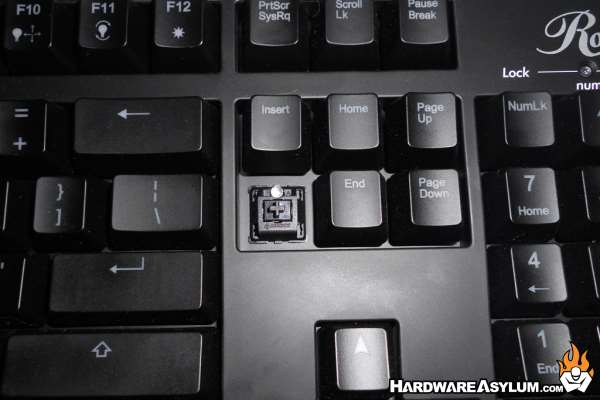Rosewill Helios RK-9200 Gaming Keyboard
Author: Warren YoungMechanical vs. Membrane
So what’s the difference between mechanical keyboards like the Helios and standard membrane keyboards?
Membrane keyboards have become a popular choice for manufacturers, due to their more cost-effective design making them cheaper to mass-produce, as well as being more resistant to dirt and liquids. Their design is based on a small rubber dome with conductive elements held apart by the bubble. Pressing the key compresses the bubble and allows the elements to connect and close the circuit, registering a keystroke. The bubble then flexes back up when you release pressure, separating the elements and also allows the key to pop back up. While cheap and efficient to manufacture, loss of tactile feedback has been an unfortunate side-effect to the mass movement over to membrane keyboards.
Unlike the one-style-fits-all feel of current membrane keyboards, mechanical keyboards do have their own unique feel, utilizing a spring-assisted switch underneath each key. There are also different varieties of switches on the market, each adding their own uniqueness to the feel of the keystroke. This gives mechanical keyboards the ability to be tailored to provide you with the feedback and responsiveness to fit your style.
Another advantage mechanical keyboards have is a much longer lifespan than their membrane counterparts. The most notable switch manufacturer in the game currently is Cherry, and their switches are rated to last up to 50 million operations per switch. That's opposed to the roughly 5-15 million found on even the best reinforced membrane keyboards.

There are two families mechanical switches generally fall under categorically, Linear and Tactile. Linear switches lack a physical response to let you know a key has been pressed, and are popular with gamers and typists and closer resemble the feel of a membrane keyboard. Tactile switches give you a physical response or a “bump” to let you know you’ve completed a key press. Cherry color codes each switch type of their MX line so you can be sure that you’re getting the type that best suits you.
On the linear side, the popular colors are either the MX Red or MX Black switches. The MX Blacks are stiffer and require more force to register, but are a popular choice with gamers since the heavier press leads to fewer accidental mis-keys. This switch is less popular for typing due to the heavier pressure required actuating the key leading to faster fatigue. A recent alternative has been the MX Red switches, which require less force to register a keystroke. MX Reds are considered to be quicker and more responsive due to the lower activation pressure, as well as friendlier to typists.
Tactile switches are a popular option for typists, and are gathering support in the gaming community. Tactile switches are also unique that you have a choice if you would like your switch to have an even more pronounced audible click or not for added feedback. Currently the most popular tactile switches with the added click are the MX Blue switches. Those tactile switches with no added audible feedback, and still retain the “bump” when you press the key are the MX Brown. While the tactile “clicky” switches are generally the loudest of the bunch, it should be noted that due to the nature of the mechanical switch, typing does tend to be a bit louder than typing on a membrane keyboard since there is no rubber pad to absorb the noise of the key presses.
The Helios I tested came with the Cherry’s MX Black switches, but the Helios will be released with your choice of Black, Red, Blue or Brown switches, so no matter what switch type you are a fan of, there will be an option available for you.
Helios 9200 models by switch type:
Model RK9200-BL (Cherry MX Black)
Model RK9200-RE (Cherry MX Red)
Model RK9200-BR (Cherry MX Brown)
Model RK9200-BU (Cherry MX Blue)

